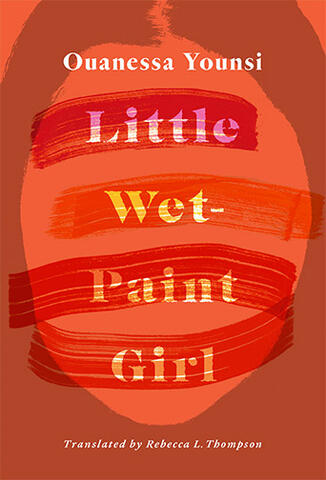
“My parents peeled me like a fig. I was a different fruit each day.” Is the self the me, an object created, or the I, with self-knowledge and even agency over its own definition? In Métissée, ably rendered in English by translator and scholar Rebecca L. Thompson as Little Wet-Paint Girl, Québec poet Ouanessa Younsi brings multiple possible selves together in a collision complicated by mixed cultural heritage.
Younsi is a significant figure in Québec literature today: as well as the poetry books Prendre langue, Emprunter aux oiseaux, and Métissée, she is the co-author of the collaborative collection Nous ne sommes pas des fées, with the emi-nent Louise Dupré. Younsi was co-editor with Isabelle Duval of an important anthology of contemporary women’s poetry from Québec, Femmes rapaillées. Younsi’s essay about the interstices of care and love, Soigner, aimer, was a finalist for the Governor General’s Award for French-language non-fiction.
Younsi is fascinating also because of her parallel professional paths: she went to medical school to honour her good grades and to do right by her immigrant father, and the dual pursuits of her specializing in psychiatry and her literary work are revealing of a simultaneous and porous inversion — the exterior, medical attempt to categorize and care or cure, and the interior, poetic work. In Little Wet-Paint Girl, as in her previous collections, Younsi turns over what makes us human, peering into the prism of selfhood to see what differ-ent angles might reveal, different strands of light, of seeing. This most recent book, her first to be translated into English, is a metaphorical and imagis-tic exposition of identity, a mapping of the tug of war of self-discovery and self-definition that characterizes humans in general, and biracial or bicultural people and immigrants more particularly.
From the two epigraphs onwards — Younsi prefaces her book by borrow-ing from the québécoise poet and novelist Anne Hébert and the Palestinian poet Mahmoud Darwish — Little Wet-Paint Girl is marked by duality, by the scream of Hébert’s girl with “neither heart nor face” and the singularity of Darwish’s interlocutor: “You are neither you, / nor anyone but you.” Starting with an exploration of the speaker’s childhood, the book looks for that iden-tity, the heart and face, defining herself ultimately in the turmoil of a self defined both by her uniqueness and by what she is not. “When I was born,” the book opens, “spirits flew from my head, their fingers stained in noise.” Younsi’s father was Algerian, her mother Québécoise, and having roots else-where is a constant clatter and source of tension, a restlessness between “the snow [that] deepened like milk poured over the city” and the “sunburned side of the world.”
The whorl of the book, the centre of gravity that constantly pulls us in, is sensory: “heads rolled like clementines,” there are scorpions, snakes, “a sunbeam of quartz and spice.” “At bath-time,” she writes, “I rinsed myself with turmeric and felt every breath run down my flanks.” The effect is a kind of poetic synaesthesia, the poet straddling the muddle or marriage of sense memory and landscape. It’s so nostalgic, so little-girl-lost, that you can taste it: as she looks back to her father’s family and homeland, “an orange tree bloomed in the room of the past.”
The paternal heritage forms the quest, largely because of its absence: we necessarily look for what is elsewhere. As a racialized child, the speaker is subject to abysmally predictable discrimination—“In kindergarten, they nick-named me chocolat because I was the brownest girl in the class”—yet that oth-ered side of her, which carries the violence of racism and exclusion, also has its own brutal baggage.
The poems progress from childhood to the speaker’s painful discovery of a family, a generation, a country shattered: “Maybe a parent died under a bomb, maybe a soldier smothered a child under a mauve pillow.” Colonial history is presented as enormous, spread like vast years over the authentic self. The phrase little wet-paint girl alludes to that slow, piecemeal obliteration that was one of the results of the waves of colonialism in the past hundred or so years: “the century touched my skin, it erased a little of my colour.” The English title, which borrows an early line from the book, pushes the reflection further: while “métissée” refers to a racially and culturally mixed woman, the emphasis on wet paint suggests not only that erasure but also its consequences: the implication of wet paint is that it can be damaged or removed, but it also evokes an imposed distance. Stay away.
Invariably, violence colours every facet of the identitary prism, from memory to longing to hope, and even to the creative act, as “a corpse spills verbs across the page.” The body, too, bears the brunt, and recurring images of injury, cleavage, and dismemberment float down like ashes. Every mark is borne physically — in the liver, the pierced flesh, the limbs, as “a mys-terious fever”; in the “ghosts [that] snapped the house’s tibias”; in the “soul [...] scoured as white as a tooth.” It is beautiful, too, both in the body, as the speaker feels the call of an unknown family through “the flutes of our veins,” and in a kind of magic realism that pervades the book, as when “a fennec [runs] down my legs,” the image darting nimbly along our reading mind, our inside skin.
Ultimately, there is beauty, and hope; a broken heart still beats, maybe only because it remembers beating. What has been lost and broken is made to be found and put back together. ”I looked for the grave of my grandmother,” Younsi writes,
What the little wet-paint girl finds is that she, as are we all, is not whole, but made of bits of hurt, of family, of stories, and perhaps stitched together by the poetry itself.










